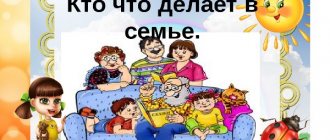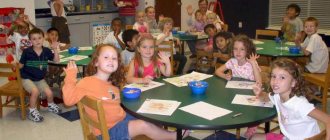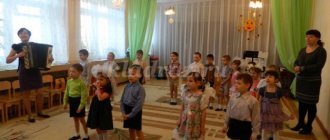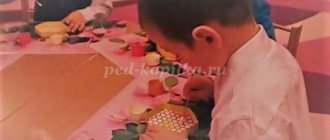Lesson on sensory education in the younger group of preschool educational institutions
Summary of a lesson on sensory education with a didactic toy on the topic: “Bunnies visiting children” for children of primary preschool age.
Program content: 1. Continue teaching children to name the properties of objects (fluffy, soft, warm, shaggy).
Strengthen children's ability to examine objects, highlight their color and size. 2. Develop fine motor skills, attention, color perception. Practice reading familiar poems, develop the ability to answer the teacher’s questions and listen to him carefully. 3. Foster a caring attitude towards animals. Material: (House for each child. A small toy bunny with red and blue bows; snowflakes cut out from paper napkins; a basket; a hare; two paths, blue and red; a model of a Christmas tree and a birch tree to create a forest landscape. Lesson progress
Children play in the play corner. A tape recording of a child's cry is heard.
Educator: Children, someone is crying! Are you not crying? Children: no Teacher : Who? Let's look. (everyone walks together, the teacher comments on the action) Teacher : Not behind the closet, not under the table. (Children find bunnies under the tree. The crying stops. Educator : Children, you and I found ourselves in a winter forest clearing.” That’s who was crying (asks) “Who is this?” (showing the bunnies) Children: Bunnies (Children pick up one bunny at a time ) Educator : Touch the rabbit with your hands. (Children stroke, feel, answer the question: What is he like? (The teacher helps, suggests the words soft, fluffy, pronounces them with all the children.) Educator: Children, why were the hares crying in the forest? Children: We got lost in the forest and can't find their house. Educator: The bunnies are cold. Let's warm the bunnies. Breathe on them. Let's pet the bunnies, hold them close. Educator: Look at the bunnies' ears (big). And the tail (small, fluffy, round). Educator : Look what beautiful bunnies. Educator: Children, do bunnies have bows? Children: Yes Educator: What color are they? Children: Blue and red. (children name the color of their bunny’s bow Educator: Do bunnies like to sit in your arms? Children: yes Educator : Children, look at the beautiful clearing in the forest. How beautiful it is, there are big and small snowflakes on the Christmas tree, and fluffy snow under the tree. Educator: Let's play with the bunnies. (Children and the teacher take napkins “snowflakes”, crumple them, forming “snowballs”, then throw them or throw them at each other. Educator : How fun we played! Let's collect snowballs in a basket. (Children complete the task) Educator : We are in a magical forest, and the little naughty bunnies can’t sit for a long time, they still want to jump. I suggest jumping along the path. Whoever has a bunny with a blue bow will jump on the blue path, and whoever has a red bow will jump on the red path. Game “Let's Jump Along the Path" Bunny jumps hop-hop-hop. Along the path jump-jump-hop. Lowers his paws. Raises his ears. The bunny loves to play and entertain the children. Educator : Our bunnies are tired. Let them rest a little, let's put them in a beautiful basket. Educator : Children, we with you we are in another clearing. And let's see what happened here? Reading verse. A bunny was walking in the forest. Somewhere he lost his ears. The bunny is sitting on a stump. He is sobbing bitterly, quietly wailing. Where are the ears, that's the trouble? And without ears there is nowhere Educator : Look, children (showing a bunny whose ears have been lost) Children, is everything okay with the hare? Children: no. Educator: Maybe he lost something in the forest? Children: ears. Educator: How many ears does a hare have? Children: two ears. Educator: Why does a hare need ears? Children: something to hear. Educator: Let's help find little ears for the bunny. (The teacher suggests attaching small ears to the bunny. The children notice the mistake. We are looking for large ears near the birch tree. Then the teacher attaches the large ears) Educator : Children, are there a lot of bunnies in this clearing? Let's help you find ears for every Bunny. (children go to the tables where there is a model of a hare and separate ears. Children fasten their ears (calm music sounds.) Educator: Now we have bunnies with ears. Let's sing a song for them and play. Game with singing: The little white bunny sits and wiggles his ears Like this, like this And he wiggles his ears. It's cold for the bunnies to sit, You need to warm up your paws. Like this, like this You need to warm your little paws. Educator: And now it's time to take the little bunnies to the mother hare. (draws attention to the hare's house) Educator: The little bunnies ran to mom, we were happy, we missed her. Hare: And in gratitude for the fact that you were good, the children treated the bunnies, I will treat you with juice. (The children come to the table, on a beautiful served table there are apples, a juicer, a glass for each child. The teacher is together prepares apple juice with a bunny. Shows the fruits and offers to extract the juice from them. When the juice is ready, pours it into glasses and invites the children to try. Asks the children to pretend to pour the juice for their bunny and give him the juice to drink.) (A song about Masha plays) Educator : You helped the bunnies find their home and mother. They are very happy and so are we all! The hare says goodbye. (She has all the bunnies in her hands.)
We recommend watching:
Summary of a game (integrated) lesson on environmental education for the 2nd junior group. A summary of the GCD in the junior group on traffic rules. A synopsis of the GCD on social and communicative development for the 2nd junior group. A synopsis of the GCD for physical education in the second junior group.
Similar articles:
Lesson summary for an early age group. Vegetables: turnips and carrots
Lesson summary for an early age group. Vegetables: beets and potatoes
Lesson summary for an early age group. Fruits: lemon and orange
Lesson summary for an early age group. Cat with kittens
Summary of a lesson in an early age group on a winter theme. Hare and fox
Article:
Program content: Introducing children to the five geometric shapes, their names and the action of equating to the standard.
Material. Demonstration: large figures: circle, square, triangle, oval, rectangle (human figures). Handout: the same smaller sized figures with “faces”, one set for each child. Cards with outline images of the same figures of the same size.
Progress of the lesson:
Educator: “Children, let’s remember the names of the human figures you know.” (The teacher shows the figures one by one: circle, oval, triangle, square, rectangle. By tracing the figure with his finger, the teacher finds out who remembers the name of the human figure).
- “Who remembers what figure this is?”
Vanya: “Circle.”
Educator: “That’s right. Vanya, please tell me, does the circle have corners? Vanya: “No”
Educator: “That’s right, the circle has no corners. Children, what kind of figure is this? Who's to say?
Arina: “This is an oval.”
Educator: “That’s right. Arina, tell me, does the oval have corners?
Arina: “There are no corners.”
Educator: “That’s right. There are no corners. What shape is an oval?”
Arina: “Elongated.” Teacher: “That’s right, Arina, sit down. Guys, what’s the next figure?”
Children: - “Triangle”.
Educator: “Well done.” Tell me, does the triangle have corners?”
Do you have children".
Educator: “Yes, there is. When you and I run our finger along the contour of a figure, it comes across corners. What is the next figure?”
Children: “This is a square.”
Educator: “That’s right. Does this figure have corners?
Children: “There are corners.”
Educator: “Why did you decide that?”
Children: “Because when we move our finger along the contour of the figure, it bumps into the corners.
Educator: “Well done.” What is the last figure?
Children: - “Rectangle”.
Educator: “Okay. Tell me, does a rectangle have corners?”
Children: “Yes, there is.”
Educator: “What is the shape of a rectangle, children?”
Children: - “Elongated.”
Educator: “That’s right. Now, guys, let's draw the outlines of these figures in the air. (The children, together with the teacher, draw the outlines of the figures in the air).
- “Well done.” Children, now let’s play with small human figures. (The children are given cards that show “beds” for each of the figures).
- “Guys, on your tables you have cards that show “beds” for each of the figures. You will need to put the “little men” to “sleep” in beds suitable for them, i.e. arrange all the figures on cards so that they coincide with those drawn. (Children complete the teacher’s assignment).
Educator: “Children, this is where our lesson with you has come to an end. Thank you all for your work."





